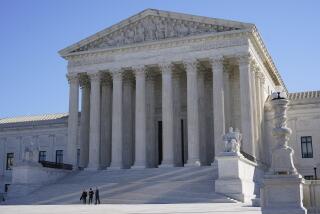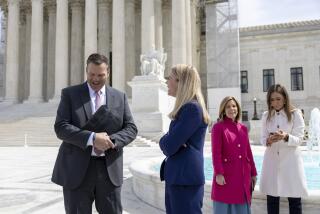High Court Affirms Right to Abortion, but Allows Some Restrictions by States : Law: The majority rules that regulations may not impose an âundue burdenâ on a womanâs right to terminate a pregnancy. Four justices favor overturning Roe vs. Wade and allowing states to outlaw abortion.
WASHINGTON â The Supreme Court, in a 5-4 decision, Monday upheld the power of states to impose limited restrictions on abortion but reaffirmed the basic principles laid down in Roe vs. Wade, saying that state regulations may not impose an âundue burdenâ on a womanâs right to terminate an unwanted pregnancy.
âA state may not prohibit any woman from making the ultimate decision to terminate her pregnancy before viability,â Justice Sandra Day OâConnor said for the court. âThe central holding of Roe vs. Wade must be reaffirmed.â
At the same time, the court said that states may impose restrictions related to health and other matters, so long as the regulations do not âplace a substantial obstacle in the path of a woman seeking an abortion.â
Specifically, the justices upheld most provisions of a Pennsylvania statute that, among other things, establishes a 24-hour waiting period for adult women seeking abortions and requires teen-agers to get the consent of a parent or a judge before ending a pregnancy.
But they struck down a provision requiring a woman to notify her husband of her plans, citing it as an example of an undue burden.
Joining OâConnor in the majority were Justices Harry A. Blackmun, author of the 1973 Roe decision, Anthony M. Kennedy, David H. Souter and John Paul Stevens.
In dissent, Chief Justice William H. Rehnquist was joined by Justices Antonin Scalia, Clarence Thomas and Byron R. White in declaring that he was prepared to overturn Roe vs. Wade entirely and permit states to outlaw abortion.
Mondayâs ruling, in this yearâs most closely watched case, undercuts for now the movement to enact ever-stricter regulations on abortion and appears to invalidate recent laws in Utah, Louisiana and the territory of Guam that make most elective abortions a crime.
Yet the new legal framework set by the court--although seemingly designed to reduce the level of controversy by setting out a detailed explanation of the courtâs views, is likely to spur a series of new legal challenges and state legislative battles.
Nor is it likely to remove the issue from the realm of electoral politics.
The ruling, however, does end the high courtâs term on a surprising note. As with last weekâs decision invalidating prayers at a public school graduation, the 5-4 majority reaffirmed a controversial precedent, rather than undercutting it as many had expected.
Advocates on both sides of the abortion dispute were thrown off stride by the decision.
James Bopp Jr., general counsel for the National Right to Life Committee, called the ruling âa major loss. This court has given us very little hope that anything can be done about the basic problem of abortion on demand.â
Kathryn Kolbert, the lawyer for the Planned Parenthood clinics that challenged the Pennsylvania law, also described the decision as a setback because the justices said that they no longer would strike down all regulations affecting abortion.
âNevertheless,â Kolbert said, âwe are gratified that they did not go as far as they could have gone in taking away rights from all American women.â
Neither side had predicted that the court might use the Pennsylvania case to explicitly reaffirm the Roe decision. Rather, opponents and supporters of the original decision had anticipated that the court would narrow the right to abortion somewhat this year and possibly overturn the right in a subsequent case.
Instead, the ruling appears to foreclose the possibility of outright repudiation of Roe, at least until the makeup of the court changes again. The five justices in the majority said they would stand behind the abortion precedent, though activists on both sides noted that a new justice could tilt the balance on the abortion issue.
Still, Mondayâs decision marked a clear triumph for OâConnor, the only woman ever to serve on the high court. She has persistently sought the middle ground on an issue that activists on both sides have repeatedly painted in absolute terms. Liberals have insisted that almost no regulation could be permitted, whereas conservatives have argued that almost any state regulation, including a criminal ban on abortion, should be permitted.
Confounding expectations, OâConnor found two new allies for her moderate view: Kennedy and Souter. Together, they fashioned a 60-page opinion that preserves for women the basic right to choose but allows state officials more leeway in setting regulations.
In a dramatic scene in the courtroom Monday, the three took turns reading parts of their opinion from the bench.
âSome of us as individuals find abortion offensive to our most basic principles of morality, but that cannot control our decision,â OâConnor said. âOur obligation is to define the liberty of all, not to mandate our own moral code . . . . The destiny of the woman must be shaped to a large extent on her own conception of her spiritual imperatives and her place in society.â
Kennedy, the 55-year old Sacramento native and appointee of President Ronald Reagan, stressed that the Constitution creates a ârealm of personal liberty which the government may not enter . . . . At the heart of liberty is the right to define oneâs own concept of existence, of meaning, of the universe and of the mystery of human life.â
Souter, President Bushâs first appointee, dwelt on the importance of adhering to a precedent, even one that has sparked national dispute.
âAn entire generation has come of age free to assume Roeâs concept of liberty in defining the capacity of women . . . to make reproductive decisions,â Souter said, and to overturn Roe now would undermine âthe legitimacy of the court.â
The majority explicitly rejected the Bush Administrationâs call for overturning Roe and instead declared that its âessential holdingâ is âreaffirmed.â
Even Blackmun seemed shocked to find three new allies for reaffirming the basic right to choose abortion. In recent years, Blackmun has glumly predicted to all listeners that Roe is âabout to go down the drain.â
âBut now, just when so many expected the darkness to fall, the flame has grown bright,â Blackmun wrote. âMake no mistake, the joint opinion of Justices OâConnor, Kennedy and Souter is an act of personal courage and constitutional principle,â he said.
Though the abortion issue transcends partisan political lines, Democrats generally have supported the right to abortion and the Republican Party has opposed it. Yet all five justices reaffirming the Roe decision were appointed by Republican presidents.
During the weeks preceding Mondayâs decision, many abortion rights advocates argued that any decision upholding the power of states to impose restrictions on abortion would constitute a mortal blow to Roe vs. Wade.
In fact, however, the statesâ power to regulate abortion had been affirmed by the court three years ago in a case titled Webster vs. Reproductive Health Services. At that time, though the court was splintered, a clear majority supported the principle of state regulation.
Four justices, including Kennedy, signed on to an opinion written by Rehnquist in the 1989 case that affirmed regulation but went further to assert views that would have cleared the way for a near-complete ban on abortion.
Blackmun, Stevens and then-Justices William J. Brennan and Thurgood Marshall rejected that view, and OâConnor provided the deciding vote by supporting regulation but saying that she saw no need to reconsider Roe vs. Wade at that time.
Since then, Brennan and Marshall--the courtâs two staunchest liberals--have retired and have been replaced by Bush appointees Souter and Thomas.
Those changes in the courtâs makeup fueled speculation that a Rehnquist-led majority had the votes to abandon the right to abortion completely.
Kennedyâs vote Monday in the Pennsylvania case sparked the most surprise. Last week, he parted company with the chief justice on the school prayer issue, and Monday he did the same on the abortion issue. With Souter and OâConnor, he formed the new moderate-conservative coalition to uphold the abortion right.
Conservative legal activists in Washington, who fought to win Senate confirmation for Kennedy and Souter, said they felt betrayed. âThe liberal spin doctors are saying this decision is a disaster,â said Thomas Jipping, a legal analyst with the Free Congress Foundation. âYet the Court did exactly what Planned Parenthood asked it to do, namely reaffirm Roe vs. Wade.â
Thomas did not disappoint the conservatives, however. After saying last fall that he had not formed a firm opinion on the abortion issue, he joined the dissenters Monday in saying that the Roe ruling is wrong and should be reversed.
âThe imperial judiciary lives,â Scalia said in one of two dissents. He derided the majority for imposing âa rigid national rule (permitting abortion) instead of allowing regional differences.â
In his dissent, Rehnquist insisted that Roe âwas wrongly decidedâ in 1973 and âshould be overruledâ now. Thomas and White signed both dissents.
Citing a view that she has taken since 1983, OâConnor said the Constitution forbids only regulations that put an âundue burdenâ on a womanâs right to choose abortion.
This means, for example, that a state can require doctors to give pregnant women a pamphlet on the risks of abortion. They may also encourage women to consider alternatives such as adoption.
Further, lawmakers can enact rules to assure that a pregnant womanâs choice âis thoughtful and informed,â the court said. The Constitution does not even bar the state âfrom expressing a preference for normal childbirth.â
But OâConnor stressed that this rule-making authority is limited. State officials can pass new laws âcalculated to inform the womanâs free choice, not hinder it,â she said. âWhat is at stake is the womanâs right to make the ultimate decision.â
A pregnant woman retains this freedom to choose abortion until the point at which the fetus becomes viable, or capable of living on its own. At that point, the state may forbid abortions, the court said, though the justices noted that they were setting aside the strict âtrimesterâ timetable set forth in Roe vs. Wade.
The court then applied that legal framework to a 1989 Pennsylvania abortion law.
First, the government may require doctors to give pregnant women âtruthful and non-misleading informationâ about abortion and alternatives such as adoption. The physicians may also be required to wait 24 hours before performing the procedure except in medical emergencies. These regulations help ensure that a pregnant woman makes an âinformed choiceâ and do not put âan undue burdenâ on her decision, the court said.
Second, the state may require that a pregnant minor get the consent of one parent, so long as she can avoid this requirement in a âmedical emergencyâ or by getting a waiver from a judge.
Third, the state may require that abortion clinics keep records on the procedures performed, so long as the identity of the patients is kept confidential.
Fourth, the state may not require that an adult woman notify her husband of her intention to get an abortion. A womanâs right to choose abortion is paramount, OâConnor said.
âThe husbandâs interest in the life of the child his wife is carrying does not permit the state to empower him with this troubling degree of authority over his wife,â she said. Pennsylvania officials said that at least 95% of married women do discuss their abortion plans with their husbands, but the state cannot force reluctant wives to do so, the court said.
Altogether, the justices wrote 167 pages of opinions and dissents in the case (Planned Parenthood of Southeastern Pennsylvania vs. Casey, 91-744).
In the end, the outcome affirms entirely the decision reached last year by the U.S. appeals court in Philadelphia. It upheld the new Pennsylvania regulations, except the requirement that women notify their husbands. Both sides had appealed to the Supreme Court.
How the Justices Lined Up in 5-4 Decision
To Uphold Roe vs. Wade OâConnor Kennedy Souter Blackmun Stevens
Sought to Verturn Roe vs. Wade Rehnquist White Scalia Thomas
More to Read
Get the L.A. Times Politics newsletter
Deeply reported insights into legislation, politics and policy from Sacramento, Washington and beyond. In your inbox three times per week.
You may occasionally receive promotional content from the Los Angeles Times.











